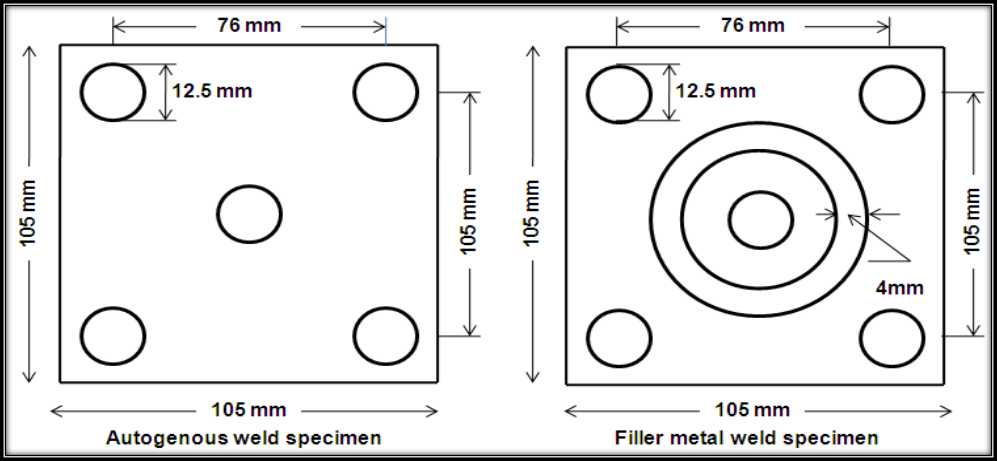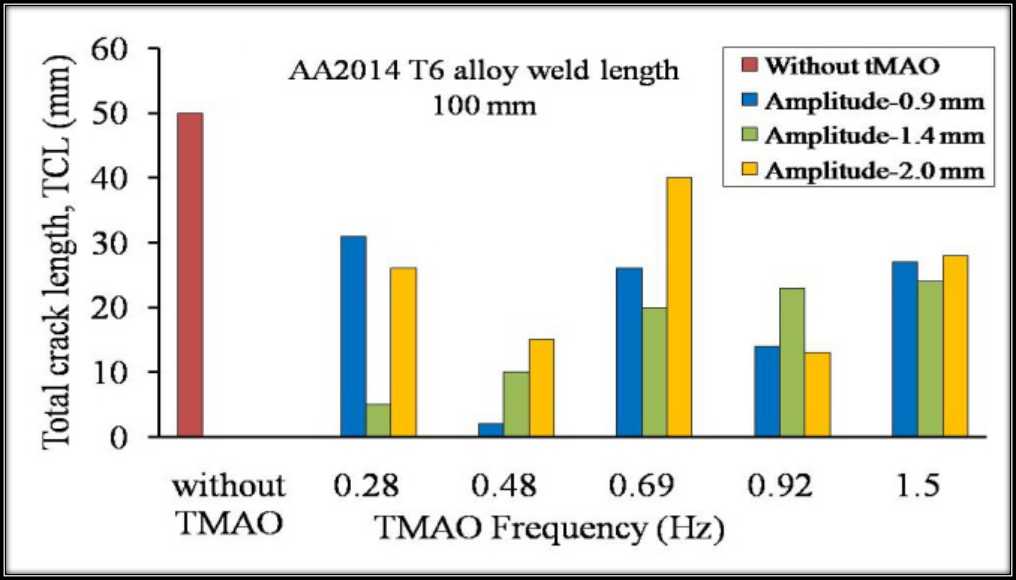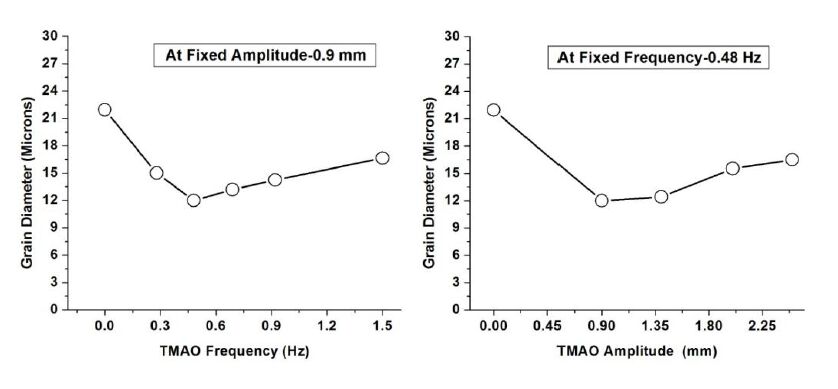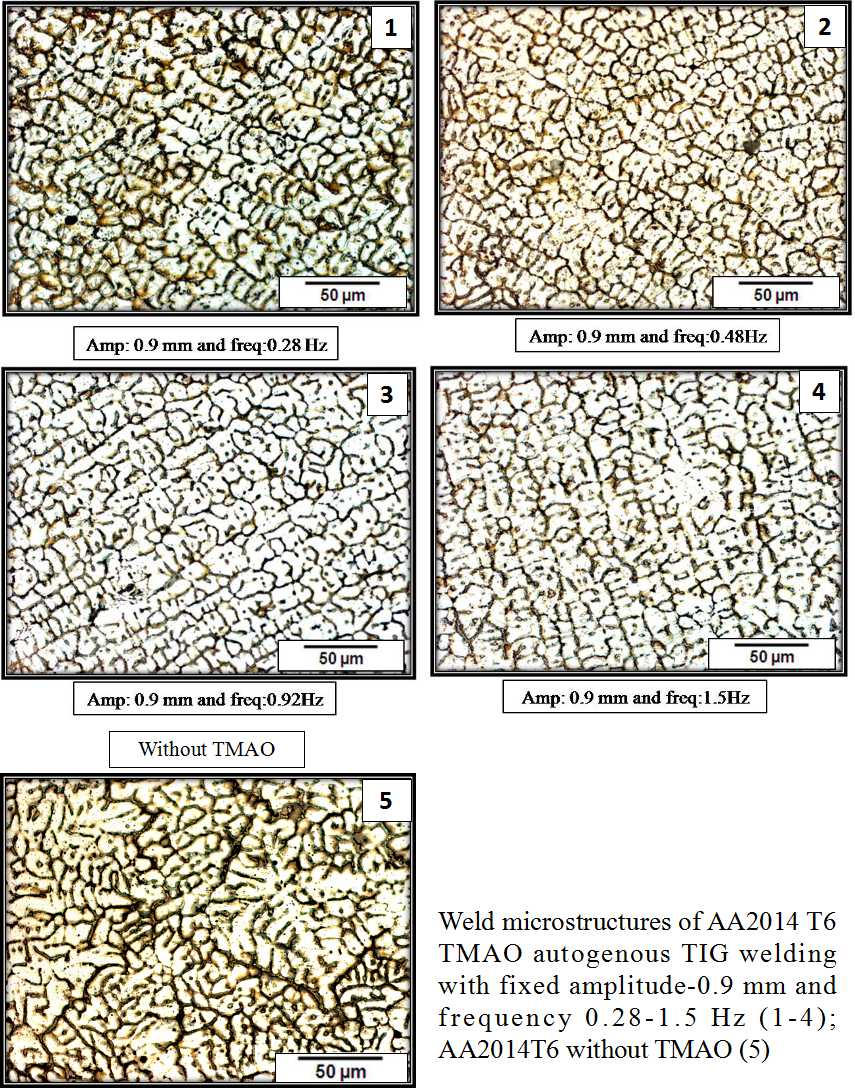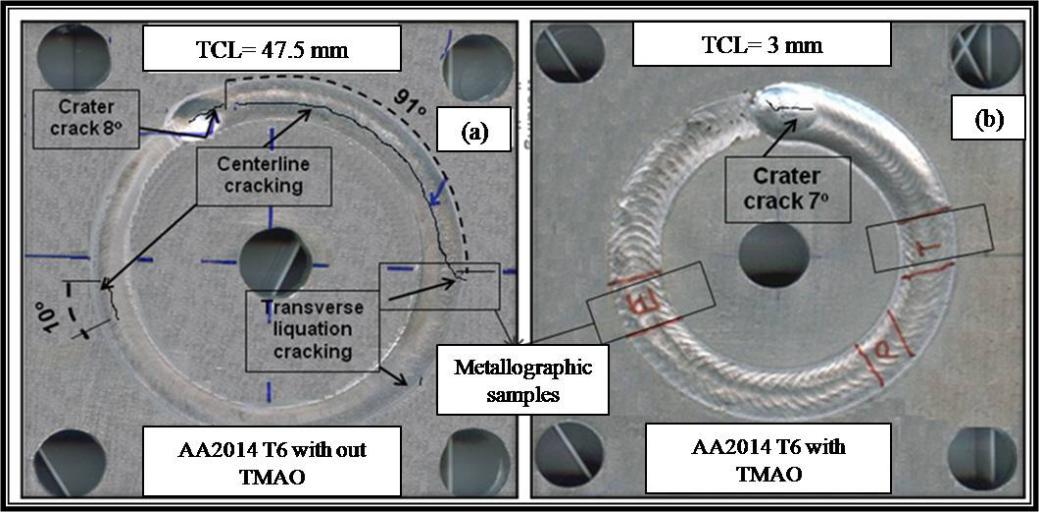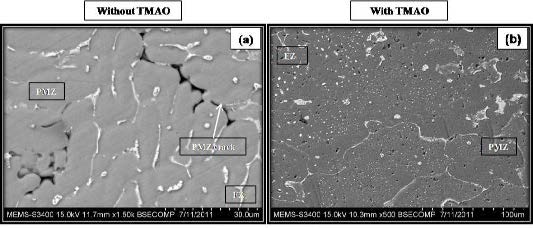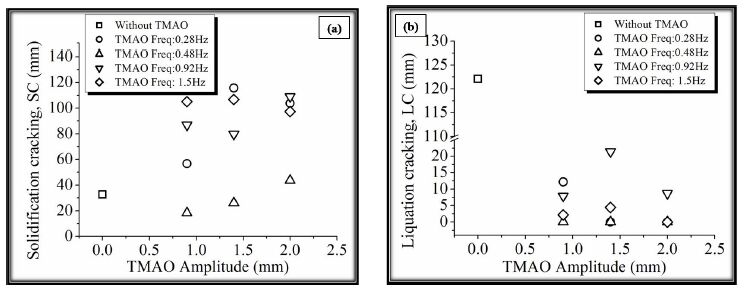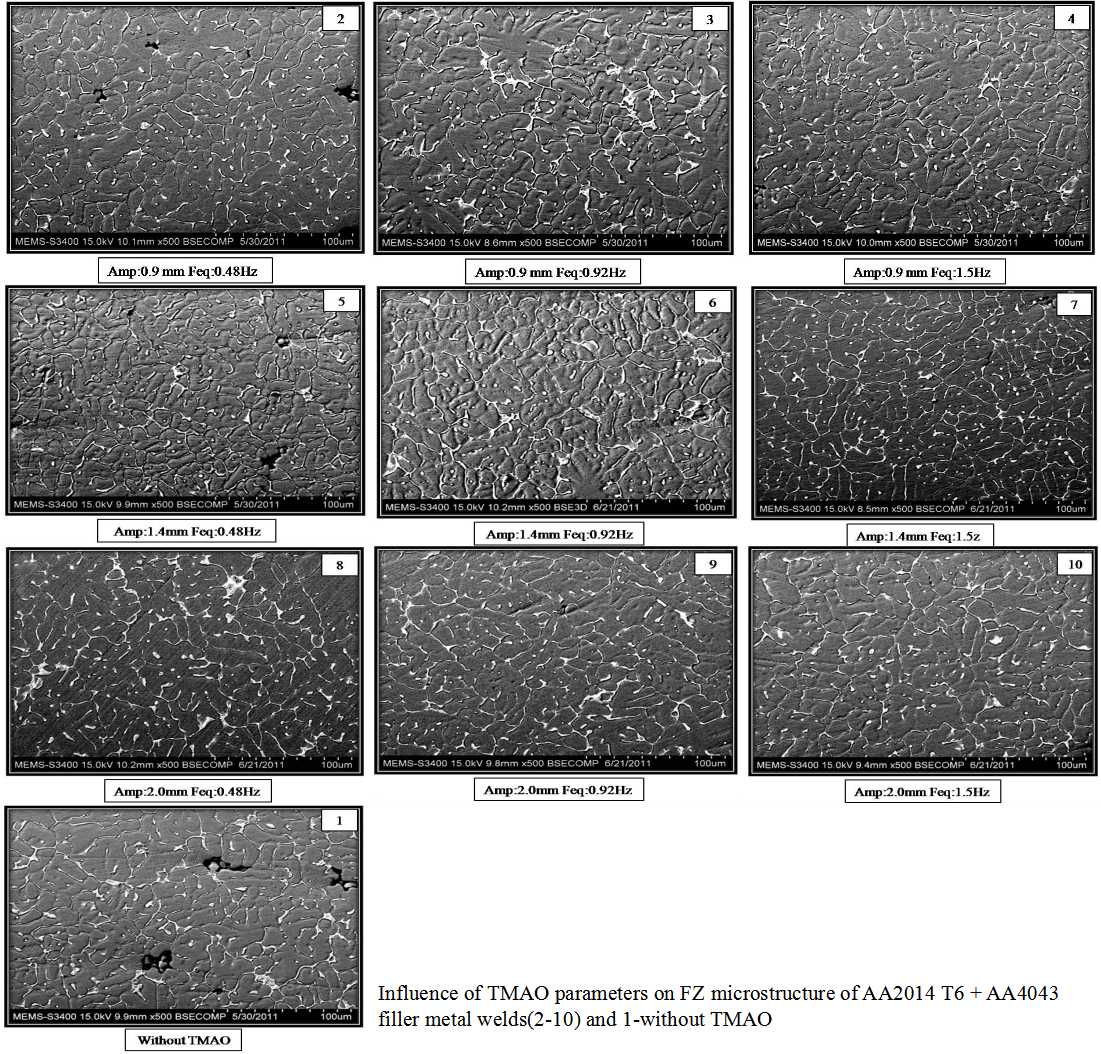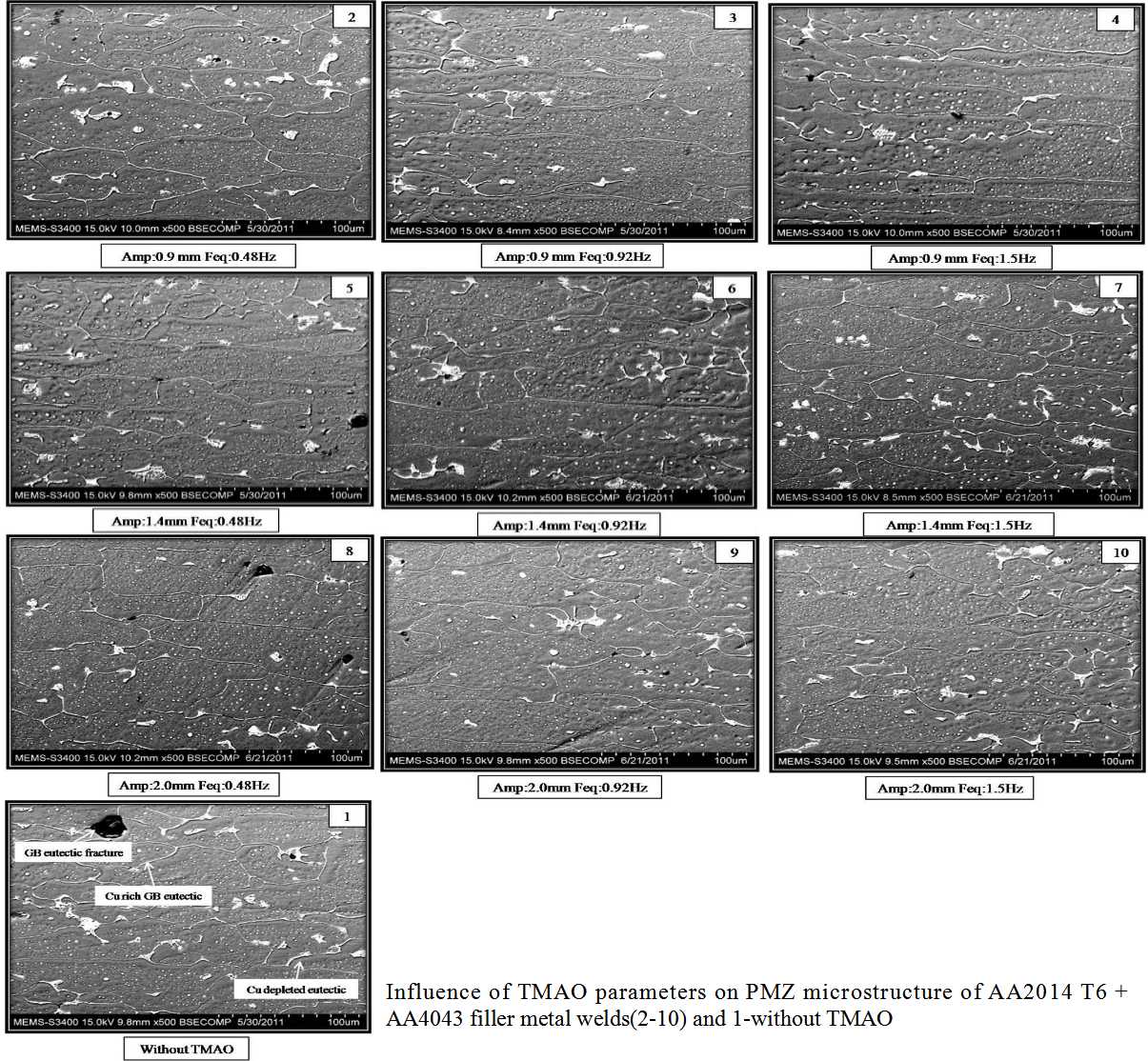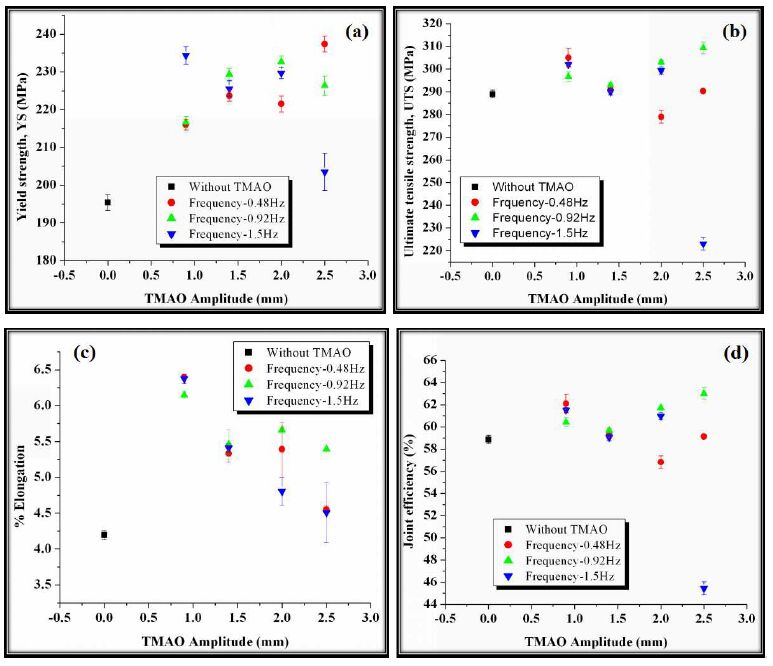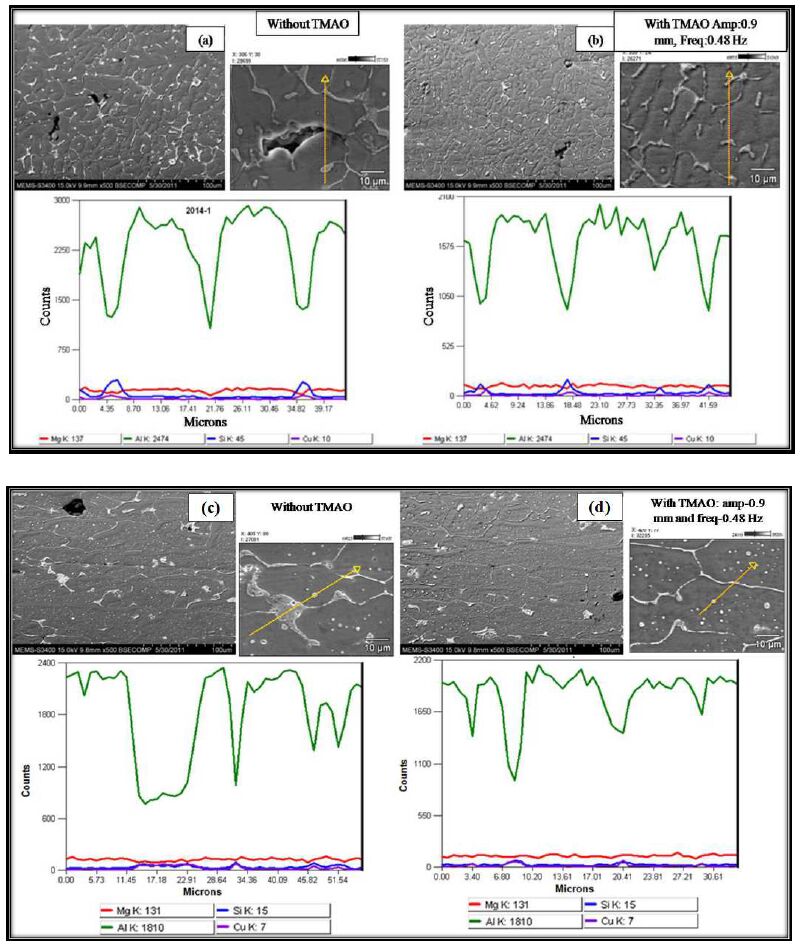1. Introduction
High strength aluminum alloys, due to their favourable strength/weight ratio, are preferred for aerospace and automobile applications. However, these alloys have a tendency to hot cracking, i.e., solidification cracking in the fusion zone (FZ) and liquation cracking in the partially melted zone (PMZ), when they are subjected to fusion welding, the most popular fabrication method [1]. Although hot cracking during fusion welding is observed in many alloy systems it is particularly severe in high strength aluminum alloys which have drawbacks of high coefficient of thermal expansion, high solidification shrinkage and large solidification temperature range [2].
The phenomenon of hot cracking during fusion welding is quite complex and is due to destructive interaction between metallurgical and mechanical factors [2]. Metallurgical factors relate to formation of susceptible microstructure i.e. coarse grain and thin low melting liquid film formed in the inter-granular/dendritic regions in the fusion zone and liquation in the partially melted zone. Mechanical factors relate to generation of residual tensile stresses due to fixtures [3]. Any method used to reduce/eliminate hot cracking will aim at avoidance and/or reducing total tensile stresses developed in the welded zones.
1.1. Background of the Study
One of the well understood methods to overcome solidification cracking in aluminum alloys is use of highly alloyed filler metal so as to produce sufficient amount of eutectic to heal the cracks by backfilling [4,5,6]. In addition, other methods to control solidification cracking include modification of the solidification structure by addition of grain refining alloying elements such as Ti, Zr, V, and B in the aluminum filler electrode [7,8]. A variation of this approach is to use special solidification techniques through arc manipulation such as current pulsing [9], arc oscillation [10,11,12], and torch vibration [13], which improves the weak centreline structure besides reducing the kinetic strength of the weld thermal cycles.
On the other hand, liquation cracking that occurs in PMZ has been controlled by using dissimilar fillers having lower solidus temperatures and strength similar or lower than that of the substrate metal [14]. This criterion has been verified by Kou in Al welds and more recently in Mg welds [15]. Use of such filler metals allows the low melting constituents of the PMZ to solidify before the FZ solidifies, thus making it capable of resisting tensile stresses generated and thus avoid cracking.
Among the arc manipulation techniques, arc oscillation by electro-magnetic means (EMAO) has been the choice of most research studies reported in the recent past. Some of the metallurgical advantages of EMAO include grain refinement in the fusion zone, reduction in PMZ/HAZ width, less distortion, reduction in segregation, and reduced residual tensile stresses leading to reduced hot cracking sensitivity [9]. It is also suggested that arc oscillation can be used to minimize/eliminate LC in the PMZ [12] in aluminum alloy welds, which in any way is limited to EMAO technique only. Studies using EMAO to mitigate hot cracking, primarily, solidification cracking have also reported its beneficial effect on liquation cracking [12]. However, studies concerned to liquation cracking using arc oscillation are very scanty. In addition, it is also reported that use of the EMAO during AC TIG welding proved to be ineffective limiting EMAO to only DC TIG welding which, may not be the standard practice to weld aluminum alloys. It is understood that either arc oscillation electro-magnetically or mechanically have similar beneficial effects on mitigating hot cracking tendency in aluminium alloys [10]. This paper emphasis on beneficial effect of transverse mechanical arc oscillation (TMAO) in reducing/eliminating solidification and liquation cracking in FZ and PMZ of both autogenous and non standard AA1100 filler metal welds and impact on mechanical properties of AA4043 filler metal welds.
2. Materials and Method
2.1. Materials
Table 1 gives the chemical composition of the substrate metal and filler metal alloys used in the present study. Several welding trials were carried out to arrive at appropriate TIG welding parameters to produce full penetration welds on 4 mm thick plates both autogenously and with different filler metal, Table 2.
Table 1. Chemical compositions obtained from Spectro Chemical Test as per ASTM E 1251:200.
| Material | Mn | Si | Cr | Cu | Ti | Fe | Mg | Zn | Al |
| Substrate | | | | | | | | | |
| AA2014 T6 | 0.66 | 0.90 | 0.016 | 4.49 | 0.016 | 0.22 | 0.68 | -- | Remainder |
| Filler metal | | | | | | | | | |
| AA4043 | < 0.01 | 6.00 | -- | 0.094 | -- | 0.22 | < 0.010 | -- | Remainder |
| AA1100 | | | | 0.12 | | | | | Remainder |
Table 2. TIG welding and TMAO parameters for AA2014 T6 alloy 4 mm thick full penetration welds: a) Autogenous LWT, b) Filler metal (AA4043, 4 mm diameter) LWT, c) Autogenous CWT, d) AA4043 Filler metal, 4 mm diameter) CWT, and e) AA1100 filler CWT.
| Type of welding | Welding parameters | Common TMAO parameters & power source setting |
| AA2014 T6 | TMAO parameters | TIG settings |
| Current I | Speed u | Voltage V | Amplitude | Frequency | EP/EN | ACF | Gas flow rate (LPM) |
| (Amps) | (mm/s) | (volts) | (mm) | (Hz) | (%) | Hz | |
| a) Autogenous LWT | 168 | 3.6 | 13.6 | Without TMAO | 40/60 | 70 | 6–8 |
| 168 | 3.6 | 13.2 | 0.9 to 2.5 | 0.28 to1.5 | 40/60 | 70 | 6–8 |
| b) AA4043 filler metal LWT | 190 | 3.6 | 13.8 | Without TMAO | 40/60 | 70 | 6–8 |
| 190 | 3.6 | 14.1 | 0.9 to 2.5 | 0.48 to 1.5 | 40/60 | 70 | 6–8 |
| c) Autogenous CWT | 190 | 3.6 | 13.8 | Without TMAO | 40/60 | 70 | 6–8 |
| 190 | 3.6 | 14.1 | 0.9 to 2.5 | 0.48 to 1.5 | 40/60 | 70 | 6–8 |
| d) AA4043 filler metal CWT | 190 | 3.6 | 14.4 | Without TMAO | 40/60 | 70 | 6–8 |
| 190 | 3.6 | 12.9 | 0.9 to 2.0 | 0.28 to 1.5 | 40/60 | 70 | 6–8 |
| e) AA1100 filler metal CWT | 190 | 5.3 | 13.7 | Without TMAO | 40/60 | 70 | 6–8 |
| 190 | 5.3 | 13.9 | 0.9 to 2.0 | 0.28 to 1.5 | 40/60 | 70 | 6–8 |
| Note: Welding conditions: Arc gap = 2.0 mm, Electrode diameter = 2.4 mm, electrode tip diameter = 2.0 mm. |
2.2. Experimental Procedure
The experimental setup developed in the present work mainly consists of AC square wave TIG welding machine, Mechanical arc oscillator MO-150, and circular weld fixture (CWT) [16]. Table 2(a & b) gives the TIG welding and TMAO parameters used to produce linear welding full penetration autogenous and filler metal welds for. Using these base welding parameters, initially linear weld test (LWT) was done both autogenously and with filler metal AA4043 without and with TMAO. In case of TMAO, the range of oscillation parameters studied includes amplitude (0.9-2.5 mm) and frequency (0.28-1.5 Hz)for both autogenous and filler welds.
Furthermore, hot cracking susceptibility test was performed on a circular welding test (CWT) using those TMAO parameters which showed high resistance to cracking tendency during autogenous linear welding (LWT). The TIG welding parameters, however, were slightly different from those of linear welds and are given in Table 2(c). The purpose of this test was to verify whether favourable results as obtained in linear welds, could be maintained at higher restraint stress levels. Beside using standard filler metals AA4043, hot cracking studies, CWT was also carried out using pure aluminum filler of commercial grade (AA1100) alloy using welding and TMAO parameters given in Table 2(d & e). The purpose of this was to further understand the beneficial effect of TMAO parameters on hot cracking tendencies-both solidification cracking in FZ and liquation cracking in the PMZ, as these filler metal welds produced severe cracking both in the FZ and PMZ while welding without TMAO.
As received alloy material in sheet form were in T6 temper condition (solution treated and artificially aged hardened). The alloy materials were down sized to 200× 100 mm and 105 × 105 mm test specimens using power saw, for both linear welding test (LWT), Figure 1 and circular welding test (CWT), Figure 2 autogenously and with filler metal respectively. For adding filler metal, a rectangular groove of 4 × 2.5 mm at the centre of the plate in case of LWT, Figure 1 (right) test specimens and a circular groove of 4 × 2.5 mm and 50 mm in diameter in CWT test specimen, Figure 2 (right) was milled in which the filler metal was pre-placed by press fitting prior to welding.
The second part of the study was aimed to verify the possible beneficial effect of TMAO in improving mechanical properties of the welds prepared with standard filler metal AA4043 which neither showed solidification/liquation cracking. A total of 12 welds were prepared for mechanical testing to see the possible benefits of TMAO. For comparison purpose, one weld was prepared without employing TMAO for each alloy.
Metallographic specimens, obtained from the autogenous and filler metal (AA4043) welds were subjected to metallographic studies in both the FZ and PMZ following standard metallographic procedures. Microstructural analysis including micro segregation, liquation, grain size and structure, the phase makeup, and compositional analysis were carried out using several microscopic techniques such as, optical microscopy (OM), secondary electron microscopy (SEM).
3. Results and Discussion
3.1. Weld Susceptibility Test
During TIG welding without TMAO, only solidification cracking in the FZ and no visible liquation cracking in the PMZ was observed, Figures 3. In case of welds prepared with TMAO, it is seen that all welds showed reduced solidification cracking sensitivity, Figure 3 in TMAO welds as compared to weld prepared without TMAO. The reduction in cracking behaviour was non-monotonic with respect to variations in TMAO parameters.
Resistance to cracking tendency was highest with TMAO welds for a particular oscillation parameters (amplitude: 0.9 mm and frequency: 0.48 Hz) in AA2014 T6 alloy welded autogenously. In the present case, TMAO parameters (amplitude: 0.9 mm and frequency: 0.48 Hz proved to be optimum in producing highest crack resistant welds. However, these may vary depending upon the basic welding parameters and processes. The dependent cracking tendency was non-monotonic, Figure 3. This non-monotonic behaviour can be explained as follows.
Due to TMAO the solidification process is continuously disturbed mechanically, resulting in breaking up of the solidification structure reducing/preventing dendritic growth. This leads to refined solidification structure even in the weld centreline. Increased cooling rate due to reduced effective net heat input (HNET) also helps in grain refinement.
Interestingly, with the optimum arc oscillation parameters, i.e., keeping fixed amplitude and varying frequency, and keeping frequency fixed and varying amplitude, maximum grain refinement has been obtained as seen from Figure 4, approximately 55% reduction in grain diameter as compared to without TMAO weld grain diameter.
In fusion welds, it is well known that, in and around the weld centreline the solidification structure is coarse columnar dendritic which is relatively weak and easily prone to solidification cracking, provided other than such as low melting phases in the interdendritic regions exists. When TMAO is employed, due to mechanical action (weld pool agitation) the dendrites breakup, resulting in grain refinement. The increased weld cooling rate due to reduced effective HNET also helps. Such an action leading to constructive interference of the weld solidification process by TMAO is mainly required, in and around the weld centreline. This phenomenon of constructive interference in the formation of weld fusion zone is somewhat similar to that of back washing, as suggested by Garland [13] who used longitudinal torch vibration to reduce solidification cracking tendency. Any deviation from the optimum arc oscillation parameters would reduce the extent of this constructive interference. Note, as a first approximation weld solidification rate (R), given by (ucosθ), where u, is linear welding speed and θ, is the angle between the normal at the point of solid/liquid interface in the welding direction [1]. Based on the above suggested mechanism, it should be noted that, if the weld width increases, the optimum amplitude will increase and vice-versa. Therefore, for a given welding current, if the linear welding speed is increased the weld width will decrease, and optimum amplitude required will reduce. On the other hand, for a given linear welding speed if the welding current is increased the width once again will increase and optimum amplitude will increase and vice-versa.
The useful amplitude, over which TMAO will be beneficial, will be decided by both weld pool size and shape of the trailing edge. These in turn will depend on the primary welding parameters, linear welding speed and welding current. As far as optimum TMAO frequency is concerned, it is likely that it will depend on the linear welding speed. Some kind of synchronization is required between the mechanical agitation action and rate of solidification. Greater the linear welding speed, greater will be the frequency required and vice-versa. In the case of full penetration welds with substrate plates of different thickness, it is quite possible that the optimum combination of TMAO will be different. This is because different thicknesses require different welding parameters for full penetration leading to differences in the weld pool size and shape. Thus, the observed reduction in cracking sensitivity can be attributed to both mechanical agitation as well as increase in cooling rate both of which leads to grain refinement. Needless to say, if the welding speed increases for a given welding current, the weld width will decrease leading to lesser amplitude of oscillation parameters, but increase in frequency and vice-versa.
It is well reported that transverse arc oscillation leads to grain refinement [9,10,12,17,18,19,20]. One of the reasons for the grain refinement was attributed to an increase in cooling rate as a result of reduced heat input (HNET) [10,12]. In the present case, net heat input was reduced due to increase in effective welding speed as a result of TMAO. Accordingly, the effective welding speed for (amplitude = 0.9 mm and frequency = 0.48 Hz) works out to be 4.0 mm/s, which is 0.4 mm/s higher than the actual linear welding speed (3.6 mm/s). As a result, the cooling rate in TMAO welds was 20% higher than that of un-oscillated welds. The cooling rate was calculated using the empirical equation used for calculating weld thermal cycle parameters [21]. Since full penetration welds were prepared, the equation pertaining to a thermally thin body was used [21]. This, however, cannot be the only reason as the reduction in cracking sensitivity does not show monotonic dependence on the reduction in effective net heatinput, which influences the weld cooling rate. Note that at a given frequency, the effective net heat input reduces with increasing amplitude and vice-versa.
Figure 5 shows optical micrographs of the typical weld metal microstructure showing superior solidification structure at the weld centreline due to the constructive interference as a result of TMAO and columnar structure in case of without TMAO welds, Figure 5. Much finer grains in the weld metal was observed at TMAO paramaters (amplitude: 0.9 mm and frequency: 0.48 Hz) which should highest resistance to solidification cracking tendency in the LWT welding test.
Figure 6 shows the overview of the macrographs of CWT welds prepared without and with TMAO for AA2014 T6 autogenous TIG welds. For better visibility, the crack path observed was traced with a dark line. From the overview of the top surface, many transverse cracks before the centerline cracks were seen, which were very minute and difficult to quantify. The circumferential length corresponding to the chosen diameterof the weld was 50 mm; the total crack length was expressed in terms of angle covered remembering that 360 deg approximately corresponds to a length of 160 mm.
Centerline cracks at different locations of the weld were observed; and these accumulated for a TCLof 47.5 mm in welds prepared without TMAO in AA2014 T6 alloys respectively, Figure 6(a). On the contrary, significant reduction in cracking tendency was observed in TMAO welds, Figure 6(b), i.e., a TCL of 3 mm. It is to be noted that these centerline cracks originated from the PMZ region, indicating transverse liquation cracking, Figure 7(a) but there was no longitudinal PMZ cracking along the circumferential length of the weld. It should be remembered that as compared to linear welds, which did not show any PMZ cracks without or with TMAO, CWT has shown indications of PMZ cracking, Figure 7(a) i n addition to FZ cracking in CWT welds prepared without TMAO. However, in TMAO welds, these PMZ cracks were also eliminated except for small FZ crater cracks, as shown in Figure 7(b).
It is interesting to note that solidification cracking and liquation cracking did not co-exist, i.e., side by side, as seen from Figure 6(a). It is also evident that liquation cracking stopped at the point where solidification cracking started. This is probably because solidification cracking in the weld metal significantly relaxed the residual tensile strains in the adjacent PMZ. Similar incidences of absence of co-existence of liquation and solidification cracking were reported when the AA2219 alloy was welded with different filler (1100, 110A, and 2219) during TIG welding with CPT [10]. The elimination of cracking was attributed to grain refinement and reduced amount of segregation alongthe interdendritic regions as a result of reduced linear effective net heat input and due to the phenomenon of constructive interference in the formation of weld fusion zone as explained in case of LWT welds earlier.
In case of welds prepared with AA4043 filler metal no incidences of solidification and liquation cracking in the FZ and PMZ were noticed in AA2014 T6 welds prepared without and with TMAO both during LWT and CWT. It was interesting to note that TMAO welds appeared to be neat with smooth surface and reduced porosity. The absence of solidification cracking is mainly due to the formation of sufficient amount of eutectic along the GB to back heal if any cracks initiated in the FZ. On the other hand, absence of liquation cracking is due to lesser solidus temperature of the weld metal as compared to the substrate, results in dilution of the substrate metal with filler, allowing the PMZ to solidify before the FZ solidifies.
In case of non standard AA1100 filler metal welds prepared with AA2014 T6 both solidification and liquation cracking tendency increased in without TMAO welds. Interestingly, when TMAO was employed a different behaviour in cracking tendency both in the FZ and PMZ was observed as seen from Figure 8(a & b). The increase in cracking tendency is due the dilution effect, which reduces extent of backfilling action leading to increased solidification cracking. Again, as in the case of autogenous welds, TMAO parameter combination amplitude (0.9 mm) and frequency (0.48 Hz), showed the least cracking tendency both in the FZ and PMZ due to improvement in the weld microstructure. The improvement in FZ structure is attributed to the earlier suggested phenomenon of constructive interference of TMAO with solidification process. As far as PMZ is concerned, there was complete elimination of liquation cracking. This was due to the increased weld-cooling rate as a result of reduced effective HNET, which results in lesser metallurgical degradations of the PMZ. It is to be noted that the benefit was more or less proportional to the extent of increase in weld cooling rate.
3.2. Microstructure Effect
3.2.1. Fusion Zone
SEM back scattered electron (BSE) images shown in Figure 9 depicts the influence of TMAO parameters (amplitude and frequency) on FZ microstructure of AA2014 T6 and AA6061 T6 with filler metal AA4043 full penetration TIG welds which showed higher weld mechanical properties. These BSE images describe the nature and formation of the eutectic along the grain boundaries (GB) and particles due to micro-segregation during the weld metal solidification as function of TMAOparameters. It is observed that the distribution of the eutectic and nature of eutectic particles in case of TMAO welds varied with respect to TMAO parameter (amplitude and frequency).
In normal TIG welding (without TMAO), the weld solidification occurs due to natural convection of the weld pool leading to columnar grain structure in the direction of maximum heat low. During arc oscillation however, the natural convection in the weld pool is enhanced due to artificial agitation by TMAO which accelerates the thermal activity of the atoms and expedites the phase disturbance and energy fluctuation. These fluctuations in energy and phase are essential for nucleation to take place in case of filler metal welds, i.e., heterogenous nucleation.
As seen from the SEM BSE micrographs, Figure 9(2-10), it is observed that for a given TMAO amplitude increasing frequency shows greater weld metal refinement. This is because at higher frequency more dendritic arms get detached and more nuclei formed are carried into the central part of the molten weld pool, which may give rise to smaller grain size in the weld region as shown in Figure 9(2-10) in AA2014 T6 alloy TMAO welds as compared to welds prepared without TMAO, Figure 9(1).
It can be inferred that TMAO parameter combinations; lower amplitude and higher frequency, Figure 9(4) showed maximum grain refinement in AA2014 T6 alloy welds. On the other hand, at lower amplitude, apart from grain refinement, GB segregation is less with discontinuous dendritic structure and broken dendrites appearing like particles throughout the microstructure as frequency increases, Figures 9(2-10). That is why at lower amplitude 0.9 with increasing frequency, the mechanical properties of the alloy welds are significantly higher than without TMAO welds.
3.2.2. Partially Melted Zone
SEM back scattered electron (BSE) images shown in Figure 10 depicts the influence of TMAO parameters on PMZ microstructure of AA2014 T6 with filler metal AA4043 full penetration TIG welds. All these images were captured from similar locations of FZ-PMZ regions of the welds. These BSE images describethe nature and distribution of the liquated and re-solidified eutectic along the GB and particles due to micro-segregation during the PMZ solidification. It is observed that the distribution pattern of the eutectic across the GB and particles in case of TMAO welds varied with respect to TMAO parameter (amplitude and frequency). The liquated and re-solidified eutectic along the GB and within grain interior is seen in the form of solute rich eutectic (white continuous line along the GB and white particles both along GB and grain interior) which is hard and brittle along with a light etched band (Cu depleted eutectic) which is soft in nature in case of AA2014 T6 alloy welds.
In TMAO alloy welds, the TMAO parameter-frequency assisted in reduced metallurgical degradation of the PMZ microstructure however, the extent of resistance to metallurgical degradation increases with increasing frequency as observed from Figures 10(2-10) for a given amplitude. At lower amplitude 0.9 mm and higher frequency 1.5 Hz in AA2014 T6 alloy the beneficial effect of TMAO on PMZ modification is highest as compared withoutTMAO weld, Figure 10(1). Thus, it can infer that TMAO has strong beneficial effect on PMZ microstructure resulting reduced metallurgical activities in improving the weld mechanical properties of the alloy welds.
3.2.3. Mechanical Properties
Mechanical testing was carried out on both alloy welds without and with TMAO. For comparison purpose mechanical test was carried on the base metal also. Mechanical properties such as YS, UTS, and elongation were 491 MPa, 433 MPa, & 7.4% for AA2014 T6 in as received condition. It is observed that there is a definite improvement in weld properties with TMAO in AA2014 T6-AA4043 filler metal, Figure 11(a-d). Welds prepared with TMAO showed noticeable improvement in all weld mechanical properties as compared to those prepared without TMAO, Figure 11(a-d). On comparison it is seen that in welds of AA2014 T6 with a standard filler metal AA4043, there is tremendous drop in mechanical properties. The extent of drop is 55% YS, 53% UTS and 71% ductility from their respective substrate metal properties.This drop in strength is attributed to negative metallurgical reactions caused by heat (weld thermal cycles) of welding in the weld and in the heat-affected zone (HAZ) as explained below.
During TIG welding, these alloys form a brittle continuous plate like Cu enriched eutectic in AA2014 T6 alloy welds similar to the one seen SEM/BSE images, Figure 12(a) aligned along the grain boundaries and eutectic structures formed by constitutional liquation in the FZ are found to be very much deleterious. Regions adjacent to the fusion boundary line, i.e., PMZ results in eutectic reaction between the eutectic present on the grain boundaries and the surrounding α phase, is found to be brittle as a result of constitutional liquation of the alloying elements mainly Cu along with Mg and Si similar to those subsequent of SEM/BSE images shown in Figure 12(c). Thus, the fusion boundary and the adjacent area, being very brittle and transverse to the applied load during tensile testing, has been found to cause drastic decrease in mechanical properties (mainly 0.2% yield strength of a single pass TIG welding as seen in the case of AA2014 T6 with AA4043 filler metal TIG welds prepared without TMAO.
On the other hand, weld prepared with TMAO of AA2014 T6 alloy weld showed significant changes in the FZ and PMZ microstructures similar to the one seen in SEM/BSE images, Figure 12(b & d) leading to improvement in weld mechanical properties under same welding conditions to those welds prepared without TMAO.
The improvement in mechanical properties as function of arc oscillation parameters did not correlated as seen from Figure 11(a-d). In case of AA2014 T6+AA4043 welds, however, it is interesting to see that excepting in the case of YS, Figure 11(a) than other properties namely, UTS, elongation, and JE. The maximum values obtained for UTS, %elongation, and JE for TMAO parameter combination of amplitude (0.9 mm) and frequency (0.48 Hz).
Furthermore, from Figure 4, it is seen that maximum grain refinement occurs at the optimum combination of oscillation parameters; amplitude 0.9 mm and frequency 0.48 Hz. The extent of grain refinement is not adequate to influence the weld strength substantially. This is because; influence of grain refinement on strength is obtainedprovided, the grain size is of the order less than 5 µm [22]. Whatever improvement in weld mechanical properties that has been seen is mainly due to, improvement in the quality of the weld microstructure in the form of i.e., non-dendritic structure, grain refinement, reduced porosity and micro cracks.
4. Conclusions
(1) TMAO reduces solidification cracking in autogenous and filler metal welds (non standard alloy AA1100) full penetration TIG welds of AA2014 T6 alloy. The maximum benefit however, was obtained at optimum combination of TMAO parameters (amplitude: 0.9 mm and frequency: 0.48 Hz)(these values will vary depending upon the welding parameters used). The dependent cracking tendency was non-monotonic.
(2) TMAO appears to benefit while welding AA2014 T6 with respect to reduction/elimination of solidification cracking/liquation cracking tendency. Reduction in solidification cracking is due to constructive interference of the TMAO with the solidification process at the weld centreline which limits the useful range of combination of TMAO parameters (amplitude: 0.9 mm and frequency: 0.48 Hz)helped by increased weld cooling rate as a result of reduced effective HNET.
As far as liquation cracking mitigation is concerned, TMAO helps in reducing the same mainly due to increased weld cooling rate resulting in less metallurgical degradation such as, amount of liquation, PMZ width leading to less susceptible microstructure. Although beneficial effect of TMAO in PMZ is always available, as far as PMZ is concerned, the choice of appropriate TMAO parameters is controlled by the requirements of reducing solidification cracking, which requires constructive interference in the solidification process.
(3) TMAO welds of AA2014 T6 with AA4043 standard filler metal showed higher weld mechanical properties as compared to without TMAO welds.
(4) Microstructural studies (optical, and SEM) of the FZ and PMZ revealed that TMAO leads to grain refinement of the solidification structure with significant subgrain formation and significant microstructure modifications in the PMZ resulting in reduced metallurgical degradation.
Acknowledgment
The author thank the Indian Space Research Organization (ISRO, Trivandrum India) and M/S. Bhakshi Kempharma, Thane, Mumbai for providing the materials AA2014 T6 and AA6061 T6 aluminium alloys respectively for the research study.
Conflict of Interest
The author declares that there is no conflict of interest regarding the publication of this manuscript.









 DownLoad:
DownLoad: 
